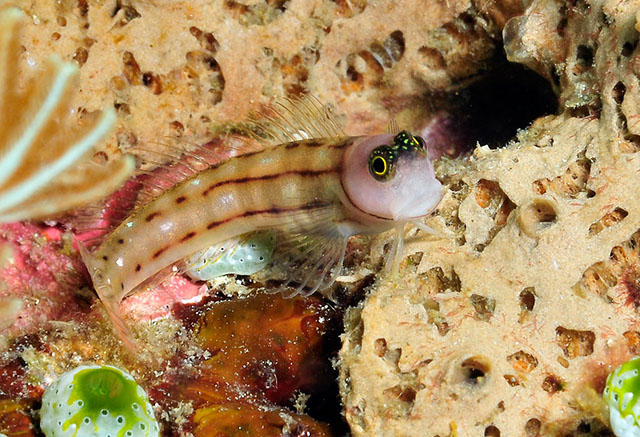| Blenniidae (Combtooth blennies), subfamily: Salariinae |
| 3.5 cm SL (male/unsexed) |
|
reef-associated; marine; depth range 0 - 15 m |
| Western Pacific: known only from the Cuyo Islands, Palawan, Philippines. |
|
Dorsal spines (total): 12-12; Dorsal soft rays (total): 13-15; Anal spines: 2-2; Anal soft rays: 14-17. Description: Dorsal fin XII,13-15 (usually 14); anal fin II,14-17 (usually 16); pectoral rays 13-14 (14 in only one specimen, and only unilaterally); pelvic fin I, 3; caudal-fin segmented-rays 13. Vertebrae 10 + 21-23 (usually 22). Incisors and canines look very similar, 42-46; posterior canines 4-7 on each side of specimens at least 25 mm SL, 42-46. Lateral line without pores, terminates below dorsal-fin spines 9-11 (usually 10). Anterior nostril with cirrus on posterior rim only. Overall pale to dusky grey with spoke-like markings on iris. Head darker in males, darkest above mid-orbital level; with spot at midpostorbital margin, dusky, may be absent, but may also extend to the opercle as a stripe connecting to the middle body stripe; some with short, diffuse, dusky stripe on opercle; with streaks on ventral surface of head from lower lip to margin of gill opening. Body with three stripes, slender, dark, equally spaced at the pectoral-fin axil region, continuous anteriorly but posteriorly breaks into dashes and spots from the region below segmented-ray portion of dorsal fin; dorsal stripe along the lateral line, middle stripe from head to caudal-fin base as a dark spot, ventral stripe from pectoral-fin axil to caudal peduncle as a dark spot; also with spots, dark, usually 4 or more spots in each "stripe"; some also with bands, faint and dusky, 7-8 along dorsal contour (Ref. 5296, 90102). Body depth 5.3-6.1 in SL, at origin of anal-fin (Ref. 90102). |
| Adults are found in coral reefs (Ref. 90102). Oviparous. Eggs are demersal and adhesive (Ref. 205), and are attached to the substrate via a filamentous, adhesive pad or pedestal (Ref. 94114). Larvae are planktonic, often found in shallow, coastal waters (Ref. 94114). Minimum depth of 0 m reported from Ref. 5396. |
|
Vulnerable (VU); Date assessed: 25 March 2009 (D2) Ref. (130435)
|
| harmless |
Source and more info: www.fishbase.org. For personal, classroom, and other internal use only. Not for publication.
